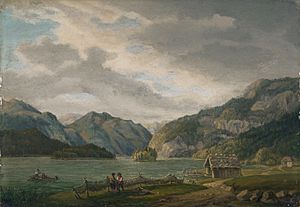Johann Baptist Isenring facts for kids

Johann Baptist Isenring (born May 12, 1796, in Lütisburg; died April 9, 1860, in St. Gallen) was a talented Swiss artist. He was known for painting beautiful landscapes and for his work as a printer. What makes him extra special is that he was also the very first person to use a Daguerreotype camera in Switzerland. This was a very early type of photography.
Early Life and Artistic Journey
When Johann was young, he learned to be a carpenter in Zürich. After that, from 1816 to 1817, he traveled to cities like Munich and Vienna. He worked there as a house painter and also as a gilder, which means he applied thin layers of gold to surfaces.
In 1820, he received a special scholarship from the Canton of St. Gallen. This allowed him to study at the Academy of Fine Arts, Munich. There, he focused on landscape painting and watercolors.
By 1823, he returned to St. Gallen. A few years later, in 1825, he started making and selling his own art prints. These were a series of aquatints, which are a type of print that looks like a watercolor painting. His series was called Thurgegenden. In 1828, he opened his own art shop. Then, in 1831, he published his biggest collection of lithographs. Lithographs are another type of print, made using a special stone or metal plate. His collection was titled Picturesque Views of the Most Remarkable Cities and Places in Switzerland.
Becoming a Photography Pioneer
In 1839, Johann heard exciting news about a new invention called the Daguerreotype. This was a way to capture images using light, creating the very first photographs. He quickly bought one of these special cameras in Paris. This made him Switzerland's first photographer!
In August 1840, he held one of the world's first photography exhibitions. He showed pictures of cities, portraits of people, and copies of famous artworks. He even printed a four-page catalog for the show. This exhibition then traveled to other cities like Zürich, Munich, Augsburg, Vienna, and Stuttgart. In 1841, he opened a "Studio for Heliography" in Munich. Heliography was another early photography method.
That same year, he made the first colored Daguerreotypes. He did this by mixing gum arabic (a natural gum) with pigments (colors). He carefully applied this colored powder with tiny brushes. Then, he used heat to make the colors stick to the photograph. He even got a patent for this amazing new technique!
The money he earned from his patent for the first eight months helped him buy something very unique. He bought his "Sonnenwagen," which means "Sun Car." This was a photography studio built on wheels, and it even had a darkroom inside! It was the first mobile photography studio of its kind.
Johann knew that a big problem with Daguerreotypes was that you could only make one copy of each picture. He tried to find a way to make duplicates. He experimented by setting up several cameras side by side or on top of each other. He tried to make them take pictures at the exact same time. However, he couldn't quite get the results he wanted. He never fully solved the problem of making perfect copies.
For many years, Johann traveled all over Switzerland and Southern Germany as a photographer. He continued this work until it became too physically demanding for him. He then settled back in St. Gallen. There, he mostly worked as a landscape painter and an engraver.
Sadly, most of his early photographic work has not survived over time.


